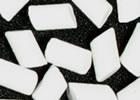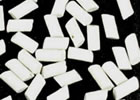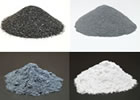Ocean Jasper Tumbling Rough
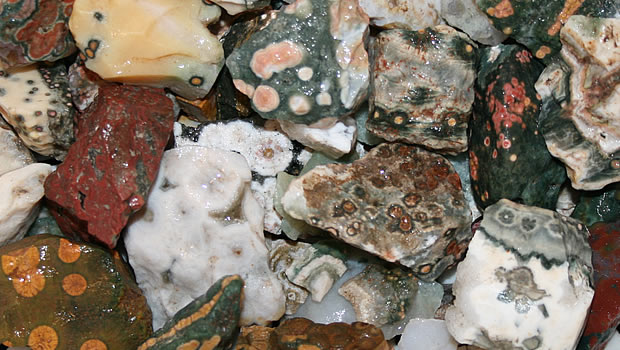
This photo shows some of our rough ocean jasper. The rough in the photo above is wet to show full color.
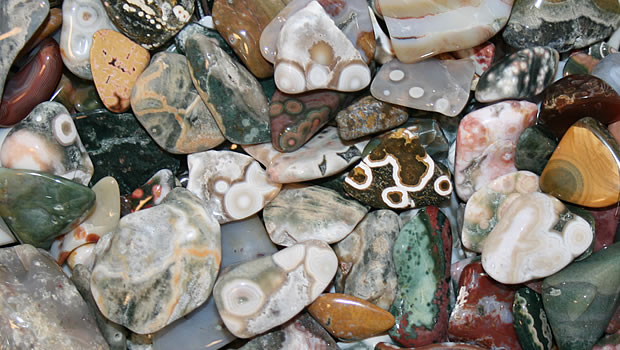
This is a photo of some ocean jasper that we polished. The different colors and patterns made some very interesting stones.
Ocean Jasper Tumbling Rough
Size: mostly 3/8 to 1 1/2 inch pieces
Ocean jasper is one of the most colorful and beautiful tumbling roughs that we have ever seen. It is a multi-color chalcedony with amazing orbs and bulls-eye patterns. It is mined at two locations on the west coast of Madagascar. (The rough in the photo above was photographed wet to show full color.)
Ocean jasper has become famous and easy to recognize because of the colorful orbs and spheres scattered through the material. These produce beautiful round markings on the surface of tumbled stones, beads, cabochons or slabs made from the material. A few pieces contain small vugs lined with druzy quartz, which sometimes survives through the tumbling process. Many pieces actually contain quite a bit of agate so a better name for this material might be "ocean chalcedony" - but "ocean jasper" is easier to say and spell :-)
The ocean jasper that we are selling has a broad color range that includes whites, creams, greens, yellows, reds, pinks and browns. It is pre-packaged in two pound bags, with each bag containing a diversity of color and pattern. When we tumble a couple of pounds we always find pieces that surprise us.
Ocean jasper rough is getting harder and harder to find. The two deposits on the west coast of Madagascar have been minded for a couple of decades and will one day be worked out. That's what happens when a beautiful rough enters the market and rockhounds love it.
EASY Rock Tumbling Recipe:
Ocean Jasper (3/8 to 1 1/2 inches)
This ocean jasper has been crushed and sized to perform well in small rotary tumblers such as the Thumler's MP-1, A-R1, and A-R2. The size range gives the material a good tumbling action and eliminates the need for ceramic media. Our EASY Rock Tumbling Recipe works well for rough that has a Mohs hardness of 7 and has been crushed to a variety of particle sizes under about 1 1/2 inches.
Recipe for Rotary Tumbling
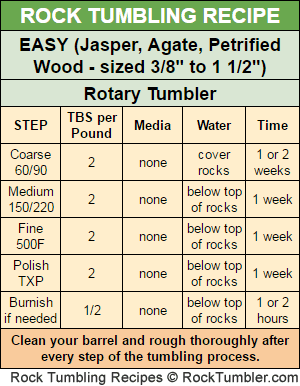
Coarse Grit Step:
Fill your tumbler barrel about 2/3 full of rough. Then add 2 tablespoons of coarse (60/90) grit per pound of material in the barrel. Add water to just below the top of the rocks. Run the material in coarse grit for 1-2 weeks. One week in coarse grit will give you good results. However, we feel that two weeks in coarse grit gives you much better results.
At the end of all steps in the rock tumbling process, make sure to clean your rocks and barrel to reduce the chance of coarser grit contaminating the finer grit steps..
Medium Grit Step:
Put your cleaned rough back into the barrel. Then add 2 tablespoons of medium (150/220) grit per pound of material in the barrel. Add water until it is just below the top of the rocks. Let it tumble for one week.
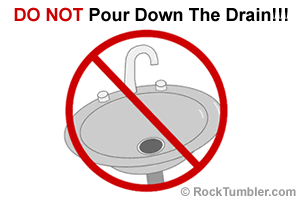
Barrel slurry dumped down the drain will harden like concrete.
After clean-up, put the rocks back into the barrel using 2 tablespoons of fine grit per pound of material. Again add water to just a little below the top of the rocks. Tumble for one week. The rocks should now be smooth and possibly starting to get a slight luster.
Polish Step:
IMPORTANT: Make sure that your barrel and rough have been cleaned thoroughly. Any grit carried over from a previous step will likely ruin your polish. Place the rough in the barrel with two tablespoons of TXP polish for each pound of material in the barrel. Add enough water to almost cover the rocks and let it tumble for one week.
Burnish If Needed:
Jasper, agate and petrified wood usually take a great polish. However, burnishing this material after the polish step can often improve the shininess of the finished stones. If you would like to try burnishing to see if it improves the look of your polished stones full burnishing instructions can be found here.
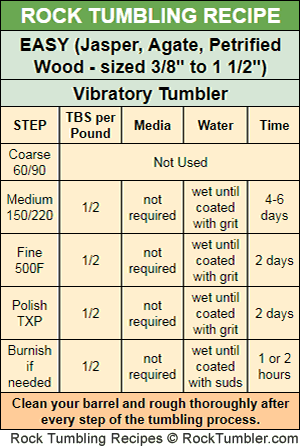
EASY Vibratory Tumbler Recipe:
3/8" to 1 1/2" crushed rough
Coarse Grit (60/90 Mesh):
Coarse grit is not used in a vibrating rock tumbler.
Medium Grit (150/220 Mesh):
Ceramic media is not required, however, we always run at least 20% ceramic media in a vibratory tumbler because we believe that it improves the tumbling action and results in nicer tumbled stones.
After you have your bowl loaded to the manufacturer's recommended level add 1 tablespoon of grit for every two pounds of material, including the media, in the bowl. While the tumbler is running, slowly add water until the material has a thin coat of wet grit and the tumbling action is smooth and fast in the bowl.
Check the bowl every 8-12 hours to ensure the action is still good. If the action has slowed, add water a little at a time until the action is back to normal. If the mud gets too thick you will need to do a complete rinse of the material and bowl. After rinsing, add fresh grit and water and start tumbling again. You are done with medium grit when you are satisfied with the shape and smoothness of the stones. Usually 4-6 days for us with this material. Give the material and bowl a thorough cleaning before moving on to fine grit.
Fine Grit (500F Mesh):
Place your material back in the tumbler bowl, then add enough polished ceramic media to bring the load up to the manufacturer's recommended operating level. Add one tablespoon of polish for every two pounds of material in the bowl. Then, turn the tumbler on and slowly add water until the material has a thin coat of wet grit and the tumbling action is smooth and fast in the bowl.
Open the bowl every 8-12 hours to check the action is still good. We usually run fine grit for 48 hours. Thoroughly clean the bowl and material before moving to the polishing step.
Polish (#61 Rapid Polish or TXP):
Make sure that your barrel and rough have been cleaned thoroughly. Place the cleaned material back in the bowl. If needed, add ceramic media that has been previously polished, to bring the bowl up to the manufacturer's recommended operating level. Add one tablespoon of grit for every two pounds of material in the bowl. Turn on the tumbler and slowly add water. Stop adding water when the material has a thin coat of wet polish and the tumbling action is smooth and rapid.
Like the previous grit steps, open the bowl every 8-12 hours to check the tumbling action. Add water if it has slowed. We have found that 48 hours is usually all the time you need to get a good polish in a vibratory tumbler. Any more time than that and you run the risk of damaging / bruising the material.
Burnish If Needed:
Jasper, agate and petrified wood usually take a great polish. However, burnishing this material after the polish step can often improve the shininess of the finished stones.
Customers also bought...
Large Ceramic Media

Small Ceramic Media

Standard Grit Kit



